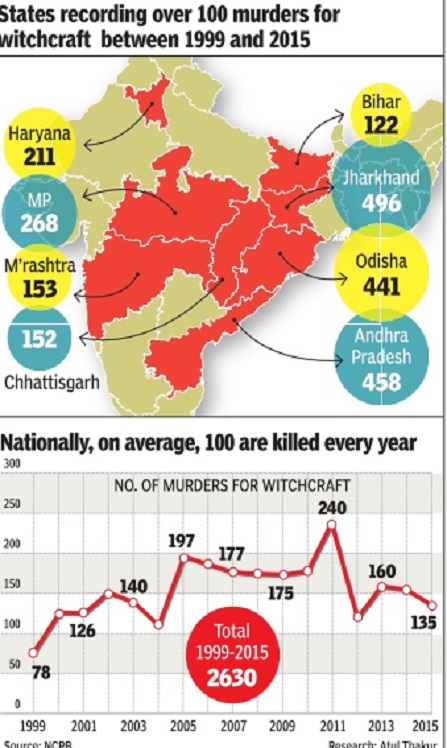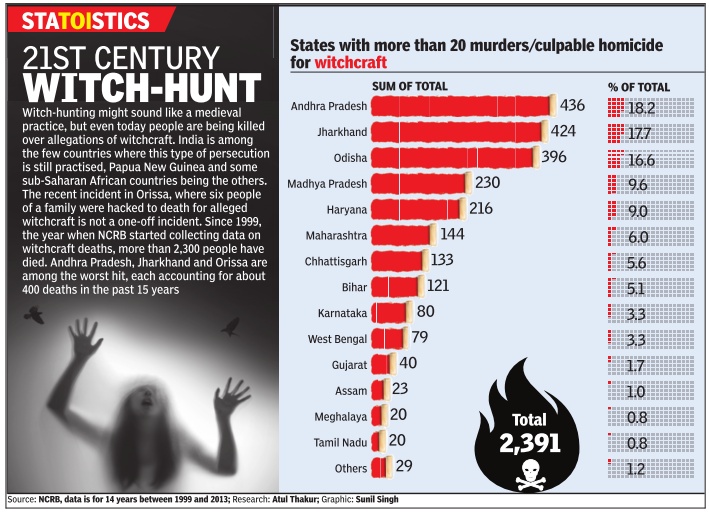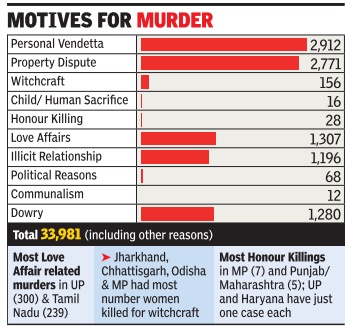Witch-hunting: India
m (Pdewan moved page Witchcraft: India to Witch-hunting: India without leaving a redirect) |
(→Witch-hunting) |
||
| Line 11: | Line 11: | ||
[[Category:Crime |W ]] | [[Category:Crime |W ]] | ||
| − | =Witch- | + | =Witch-hunts= |
== Murders for witchcraft, 1999-2015== | == Murders for witchcraft, 1999-2015== | ||
Revision as of 20:22, 8 August 2017

The Times of India
This is a collection of articles archived for the excellence of their content. |
Contents |
Witch-hunts
Murders for witchcraft, 1999-2015
INDIA STILL KILLS AROUND 100 `WITCHES' EVERY YEAR, Nov 07 2016 : The Times of India
India, which considers itself a modern nation on the threshold of global power status, is still hunting down `witches', the most recent being the murder of two women in Assam. Since 1999, when National Crime Records Bureau (NCRB) started collecting data on such deaths, more than 2,600 have been murdered on this count
In Jharkhand
The Times of India, Aug 16 2015
Vishant Agarwala
Mandar (Ranchi district)
Could the recent lynching of five women accused of practising `black magic' in rural Jharkhand be planned murder? Sunday Times investigates

Kanjiya Maraitoli is now a ghost village, with a pall of last week's horror hanging heavy over its 40-odd mud houses. The grisly mass murder of five “witches“ on the night of August 7 has touched every home here -every household has either a victim or an accused. As of Wednesday , 31 people from the village with a population of about 200 have been arrested. Several others have run away , afraid of police action.
Taking a detour from NH-75, about 40km from Ranchi, the first thing one sees is a group of young children -including an infant -leaving the village with their belongings. The kids are led by Khushbu Tigga, the niece of Bipin Khalkho, whose death due to jaundice triggered an unprecedented witch-hunt. Every adult member of the Khalkho family is behind bars and the kids are heading to another village to live with their relatives.
Even in Mandar, one of the more d e ve l o p e d b l o c k s i n r u r a l Jharkhand, superstition runs deep -the ill prefer to visit a `bhagat' (witch doctor) instead of a hospital.The little ones are convinced that the five dead women were witches. “We know they were up to no good. There were times when we found Etwariya Khalkho staring at us through the window at night. `Go to sleep or I'll suck your soul out', she'd tell us,“ says Khushbu. “She is responsible for my uncle's death,“ she adds, before heading out of the village.
Little Khushbu is one of the few people who'll talk about what happened that night. Every other person was apparently either drunk or asleep. “I can hardly see and hear,“ says an elderly tribal as he walks past. “I have no idea about what happened. I only came to know about the incident when I woke up the next morning.“
After a bit more cajoling, an elderly couple blame the five women for most of the deaths and diseases that have taken place in the village over the past 12 years. Some even hold their “dark magic“ responsible for the death of their cattle. “Etwariya was seen near a cemetery on Friday night.She definitely was a witch,“ mumbles Somra Khalkho, as his wife nudges him to keep quiet.
Karamdev Khalkho, son of one of the victims, Madni, said a few villagers had visited Etwariya's home and accused her of practising black magic two days before the lynching. “Her two sons assured the villagers that they would not stop their mother from being punished if they could prove the charges,“ says Karamdev . “None of the other women, including my mother, had any inkling that they were being targeted.“
Even Jacinta Khalkho's son Anil, an Army jawan posted in Himachal Pradesh, had no idea about the ac cusations against his mother. “The entire village would visit my house whenever I was on a vacation,“ Anil says. “Bottles of rum from the army canteen were always a coveted commodity here and I brought several of them for the villagers. I never thought these same people would murder my mother.“
There is, however, a lot more to the case than meets the eye. Experts in tribal traditions say this was not a usual case of a witch-hunt. Thousands of women have been killed on the stake over the past few decades, but usually it is one, or at the most two, women who are attacked at a given time. “There has not been a case of five women being killed together in the past 25 years,“ says Prem Chand, founding member of Free Le gal Aid Committee and an anti-witchhunt crusader.
J N Oraon, former mukhiya of Mandar village and an activist working to eliminate witch-hunts, says: “Also, unlike most such cases, these women had no idea that they would be targeted. The village committee usually first warns the `witches'.Some are given an ultimatum to leave the area, while some are forced to eat faeces or stripped and paraded. Hardly any woman branded a witch is killed without a prior warning.“
Villagers say the victims were not over-friendly with each other and were not even neighbours. Also, the five women did not meet the `criteria' that brands a woman a witch. “Generally , the woman is either a widow or has lost at least one of her sons -they have to `eat up' their closest male relative,“ says Premchand Ekka, a local leader and the husband of the village mukhiya. “But only two of the five were widows and none of them had a son who had died.“
The police admit the women would have approached them had they been taunted or harassed in the past and felt they were in any sort of danger. R N Singh, officer in charge of Man dar police station who is investi gating the case, said, “The police station is barely a kilometre from the village, and we reached the spot within minutes after we got the information that a few women were dragged out of their houses and taken to the village assembly . By the time we reached the spot, all the five were dead. It seems that the murders were planned and executed within a couple of hours.“
Whatever the investigation concludes, the village will not get over the horrors of that night anytime soon.Even the police are shocked by the macabre celebrations around the five mangled bodies. “The dead-drunk villagers were sitting in a circle around the bodies listening to Nagpuri music when we reached the spot around midnight,“ says Singh. “The villagers did not let us take the bodies until next morning -they wanted the neighbouring villages to see what the fate of other witches would be."- (With Sanjay Ojha and Alok K N Mishra)
2014: 156 killed in India
The Times of India, Mar 17, 2016
Witch-hunts killed 156 in India in 2014
For those who think witch-hunts are a thing of the past in India, here is the stark reality. Witchcraft was the motive cited for as many as 127 murders committed between 2012 and 2014 in Jharkhand alone. Replying to a question in the Rajya Sabha on Wednesday , minister of state for home Haribhai Parathibhai Chaudhary quoted National Crime Records Bureau (NCRB) data to state that 26, 54 and 47 cases of “murder for witchcraft“ were reported in Jharkhand in 2012, 2013 and 2014, respectively.
As per NCRB data for 2014, tribal-dominated Jharkhand accounted for over 30% of India's “murders for witchcraft“, which stand at 156. Odisha, another state with a high concentration of tribals, reported 32 such murders, followed by MP with 24, and Chhattisgarh with 16.
2014: state-wise killing for “Witchcraft”

The Times of India, Aug 20 2015
Deeptiman Tiwary
156 killed in 2014 for `witchcraft'
As many as 156 women were killed across India for allegedly practicing witchcraft, while 28 people became victims of honour killing in 2014. The year also saw 68 political murders, and 44 died in caste conflict. Curiously , only 12 people were murdered for communal reasons in the year. Love affairs led to over 1,300 murders. These are part of the annual crime report published by National Crime Records Bureau (NCRB) which for the first time has recorded motives behind murders under various new categories.
According to the data, personal vendetta is the biggest reason for committing murder resulting in over 2900 killings in 2014. It is followed by property dispute as being the reason for over 2,700 killings. Love affairs are the third biggest killers followed by dowry and illicit relationships.
The data show that states with significant tribal popula ion or general backwardness have more killings of women accused of witchcraft. Most number of women killed with his motive were in Jharkhand (47), Odisha (32), Madhya Pradesh (24) and Chhattisgarh (16). Along with Gujarat (10), these states account for close to 90% of all such murders.
The most curious data is with regard to honour killings.Contrary to popular perception, most honour killings in 2014 were reported from Madhya Pradesh (7), followed by Punjab (5) and Maharashtra (5). The usual suspects, Haryana and UP have recorded just one case each. J&K has reported three such cases while Gujarat and Puducherry each have witnessed two such killings.
Most murders for love affairs were reported from UP (300) followed by Tamil Nadu (239). Odisha reported the maximum dowry deaths at (413) followed by West Bengal (290).
The data also show that as many 201 women were killed after rape. UP reported most number of such cases (54) followed by Maharashtra (21).